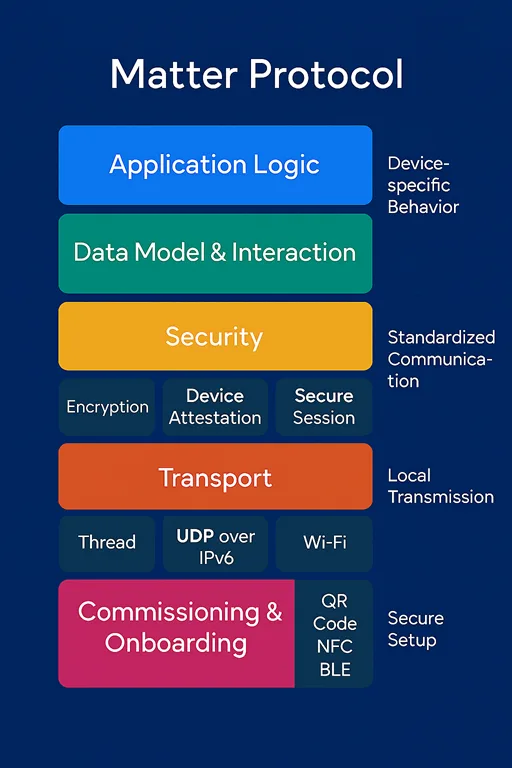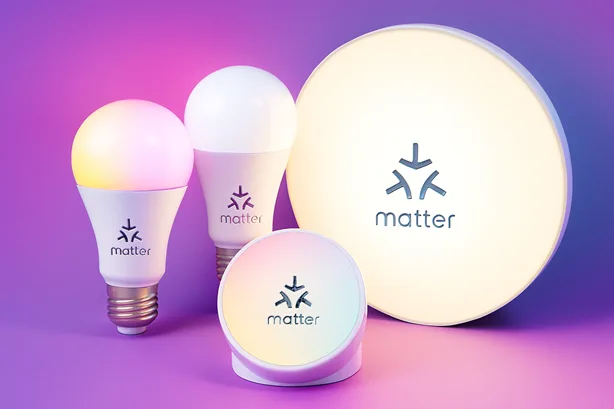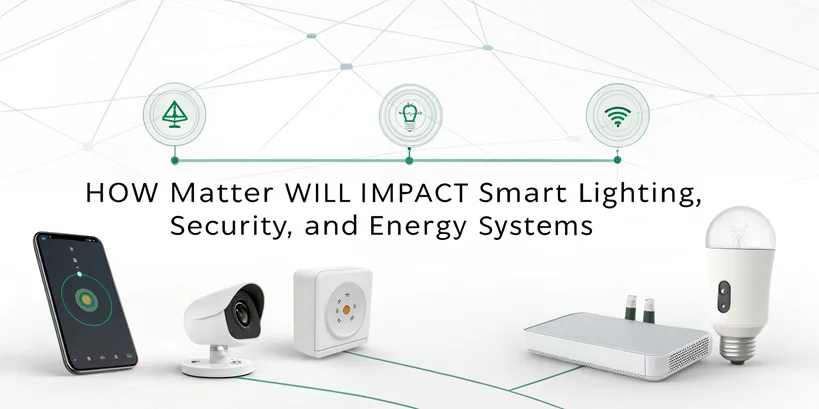Isolated ecosystems, compatibility problems, and fragmentation have long plagued the smart home sector. For many years, installing a security sensor or smart lightbulb in your house required embracing a particular hub, a brand-new app, or even a whole proprietary ecosystem. Matter protocol was introduced by Connectivity Standards Alliance (CSA) which serves as a revolutionary global connectivity standard supported by major technology companies like Apple, Google, Amazon, and Samsung the Matter embodies a bold vision that goes beyond the limitations of current protocols, aiming to enable smooth interoperability, robust security, local control, and a uniform user experience.
As of September 2025, the Matter protocol is already making a significant impact in key areas such as smart lighting, home security systems, and energy management.
This article explores how Matter is subject to transform these verticals—breaking down technical underpinnings, industry adoption, security and privacy features, energy efficiency gains, and both the opportunities and challenges that lie ahead. Drawing on the latest research, market forecasts, and real-world case studies, we detail how Matter transcends jargon and hype to deliver practical, people-first benefits for consumers, builders, and manufacturers alike.
- Understanding the Matter Protocol: Unified Interoperability
- The Matter Ecosystem: Partnerships and Industry Momentum
- Matter in Action: Smart Lighting Revolution
- Matter in Home Security: Integration, Privacy, and New Opportunities
- Energy Systems: Next-Gen Smart Energy & Sustainability
- Market Adoption and Future Forecasts
- Comparing Matter With Other Smart Home Connectivity Standards
- Challenges, Limitations, and What’s Next
- Consumer Experience and Perspectives
- Frequently Asked Questions (FAQ)
- Conclusion
Understanding the Matter Protocol: Unified Interoperability
What is Matter?
Matter is not just another protocol; it’s an open, IP-based connectivity standard designed to unify smart home and IoT device communication. Originating as Project CHIP (“Connected Home over IP”) in 2019, Matter is developed by the CSA (formerly the Zigbee Alliance) and now involves over 600 member companies, including industry heavyweights and niche players alike.
The primary objective of Matter is to guarantee that devices—whether a light bulb, a smart lock, or a thermostat—from different manufacturers can talk to each other reliably, securely, and locally. Unlike legacy protocols, Matter doesn’t lock you into vendor-specific apps or clouds. Instead, it operates over standard IP networks (Wi-Fi, Ethernet, and Thread), supports multi-admin control, and is inherently designed for easy setup, robust security, and forward compatibility.
The Technical Architecture: Layered and Open
At its foundation, Matter is engineered a top Internet Protocol (IP), leveraging familiar networking (IPv6, mDNS) and physical staples (Wi-Fi, Thread, Ethernet). This abstraction is what enables devices from different manufacturers—and across different platforms—to interoperate smoothly within the same household fabric.

The protocol employs a layered approach:
- Application Layer: Handles device-specific business logic (e.g., colour tuning for a bulb, lock/unlock logic for a door lock).
- Data Model and Interaction Model: These models define how clients and servers interact (for example, reading attributes and issuing commands).
- Security Layer: Implements strong encryption and device attestation.
- Transport Layer: Constructs data packets for local transmission by Ethernet, Wi-Fi, or Thread.
- Commissioning and Onboarding: Simplified with NFC or QR codes for quick and safe setup.
Thread support—a low-power, mesh networking protocol tailored to battery-operated and low-latency devices. Thread coexists with Wi-Fi (well-suited for high-bandwidth devices) to maximize reach and efficiency.
Open-Source, Royalty-Free, and Certifiable
The Matter standard is maintained in an open-source SDK under the Apache License, enabling device vendors of all sizes to build and certify products without steep licensing costs. Certified devices are uniquely attested in the Distributed Compliance Ledger (a blockchain-based public registry), ensuring authenticity and version traceability.
The Matter Ecosystem: Partnerships and Industry Momentum
The greatest strength of Matter is its strong alliance with multinational stakeholders, major technology producers, semiconductor design companies, platform giants (Apple, Google, Amazon, Samsung), and a fast-expanding cast of entrepreneurs. As of late 2025, there are over 1,200 Matter-certified items or in the process of certification, representing a significant increase in market penetration in just a few years.
Backwards interoperability is also a focus. Many brands (e.g., Philips Hue, Aqara, Signify, Schneider Electric, Nuki) are bridging their existing Zigbee, Z-Wave, and proprietary products into Matter networks via software updates or “Matter Bridges”, ensuring legacy investments don’t become obsolete.
Matter in Action: Smart Lighting Revolution
Seamless Smart Lighting Interoperability
Before Matter, smart lighting was plagued by platform silos—you’d need a different app (or hub) for each bulb vendor, and multi-room setups could become an exercise in frustration. According to Parks Associates, over two-thirds of households reported issues integrating lighting devices from multiple brands.
With Matter, this problem is fundamentally addressed. Matter-enabled bulbs and switches can speak the same language across Apple HomeKit, Google Home, Amazon Alexa, Samsung SmartThings, and even open platforms like Home Assistant. Whether you mix and match Philips Hue, Nanoleaf, OREiN, or Linkind, you can onboard and control all of them from your platform of choice—no more duplicate apps or proprietary pairing routines.

Technical Benefits: Latency, Efficiency, and Multi-Admin Control
Matter’s use of Thread and its multi-admin support results in measurable real-world improvements in lighting:
- Reduced Setup Time: Setting up a Matter-certified bulb takes 40% less time than traditional Zigbee or Wi-Fi bulbs according to independent studies.
- Lower Latency: Matter bulbs exhibit up to 25% faster responsiveness to commands, minimizing “lag” often seen in voice-activated routines.
- Efficient Energy Use: Thread-based Matter bulbs consume up to 20% less idle power compared to standard Wi-Fi bulbs—a tangible benefit when multiplied by the average 8.6 bulbs per US household.
| Feature | Traditional Smart Bulbs | Matter-Enabled Smart Bulbs |
| Ecosystem Compatibility | Siloed (e.g., Alexa) | Universal (Apple, Google, Amazon, SmartThings) |
| Setup Time | 10–15 min | 6–9 min (40% faster) |
| Latency (Response Time) | 300–400 ms | 225–300 ms (25% lower) |
| Idle Power Consumption | Baseline | Up to 20% less |
| Security | Proprietary, risk-prone | AES-128, 60% fewer exploits |
| Multi-Admin Control | Often single-platform | Multi-platform natively |
| Cost Range (USD, 2025) | $12–$55 | $9.99–$49.99 |
| Market Share (2026, proj.) | — | >30% of new shipments |
| Sources | CSA, NREL, NCC Group | CSA, NREL, NCC Group |
In context: The rapid adoption by Philips Hue, which made its entire Hue lineup Matter compatible via over-the-air updates, demonstrates how even established brands benefit—customers with Hue bridges can now control bulbs directly from any major platform, and new Hue bulbs will soon support direct Matter pairing.
Advanced Features and User Experience
- Voice Assistant Agnosticism: Households can control the same bulb with Alexa, Google Assistant, and Siri simultaneously.
- Scheduling and Automation: Unified routines and schedules can be set across platforms; the friction of managing multiple timers across disparate apps is eliminated.
- DIY and Scene Support: Open, royalty-free Matter means more DIY and third-party lighting automation tools can emerge—or link existing “dumb” fixtures via Matter adapters.
For end users, this all brings lower “total cost of ownership” (no more buying extra bridges or proprietary remotes) and a meaningfully improved out-of-the-box and daily experience.
Matter in Home Security: Integration, Privacy, and New Opportunities
Security Device Integration: Locks, Sensors, Alarms
Homeowners want security, yet smart locks and alarm systems have previously suffered from interoperability issues and security problems. Many systems require integrating with a specific platform—often leaving critical devices “walled in” and unreachable to the rest of the home’s automations.
With Matter, this paradigm shifts. Now, Matter-certified door locks, sensors, and alarms can work across Apple, Google, Amazon, Samsung, and open ecosystems.
Matter-Enabled Smart Locks: A Case Study
Take the Nuki Ultra Smart Lock and Aqara U200—both are Matter-certified and operate over Thread, delivering:
- Hands-Free and Multi-Admin Access: Use Alexa, Siri, or Google Assistant to unlock doors, set temporary entry codes, or automate locking routines—without switching apps or hubs.
- Enhanced Security: Matter locks employ device attestation (unique certificates), AES-128 encryption, and mutual authentication against the CSA’s Distributed Compliance Ledger, greatly reducing spoofing or man-in-the-middle attacks.
- Rapid Setup and Retrofitting: Pair via Matter QR codes or NFC, greatly simplifying installation even for DIYers and renters.
Suppose you prefer legacy hardware or have a custom door. In that case, Matter enables “bridge mode” for popular retrofit solutions such as SwitchBot’s Motorized Deadbolt Adapter and Nuki’s retrofits—bringing even classic deadbolts into a secure, interoperable network.
Security Cameras: A Work in Progress
One area where Matter lags is in video security cameras. There is no native support for streaming video over Matter as of version 1.4.2, due to bandwidth management, power constraints, data privacy, and technical hurdles (Thread and Wi-Fi multicast are not yet optimized for video streams). Many major vendors, including Eufy and Nest, continue to support cloud-based integrations while waiting for a future Matter extension.
Security and Privacy: Beyond Access Control
- Device Attestation and Secure Onboarding: Rigorous proof-of-ownership, unique digital certificates, and “no anonymous joining” policies close common IoT security holes.
- Lifecycle and Patchability: Matter security includes mandatory OTA update support, lifecycle transparency, and a coordinated vulnerability disclosure framework.
- Certifiability and Compliance: From July 2025, new EU and US regulations demand cybersecurity labeling and incident disclosure for all consumer IoT; Matter’s evidence-backed approach (CSA certification, public DCL, device attestation) is well positioned to comply.
| Security Feature | Previous Gen IoT | Matter Standard |
| Device Authentication | Weak, easy to spoof | Per-device attestation (DAC, PAA) |
| Encryption Standard | Variable, often old | AES-128, HMAC-SHA-256 |
| OTA Updates | Inconsistent | Mandatory, cryptographically signed |
| Data Residency | Vendor-dependent | Local-first, opt-in cloud fallback |
| Vulnerability Disclosure | Ad hoc | Standardized, DCL-tracked |
| Regulatory Compliance (US/EU/UK) | Patchwork | Ready for 2025–2026 acts |
The net result is a much more robust, user-transparent, and certifiable home security environment, suitable even for higher-security applications or enterprise deployments—increasing trust for insurance, lenders, and public sector buyers.
Energy Systems: Next-Gen Smart Energy & Sustainability
Matter as a Platform for Energy Management
One of the most anticipated impacts of Matter is in energy optimization and smart grid integration. As energy prices rise and governments worldwide promote electrification (EVs, heat pumps, induction appliances), a unified method for monitoring, forecasting, and automating consumption is essential.
With the rollout of Matter 1.3 (2024) and 1.4 (2025), sophisticated energy management clusters enable:
- Real-Time and Cumulative Electricity Reporting: Devices can now natively expose their power status (watts), cumulative usage (kWh), and, in future, cost signals to apps and grid controllers.
- Forecasting and Load Shifting: Energy Smart Appliances (ESA) can predict their energy needs (power forecast) and respond to time-of-use tariffs, grid signals, or weather-adaptive automations.
- Automation Across Ecosystems: With universal language, your EV charger, water heater, smart plug, and even solar inverter all “speak the same language,” ready for cost-saving and carbon-reducing schedules.
Example Device: NXP/Geo SeeZero HEMS
Geo’s SeeZero home energy management system, powered by NXP’s Matter-optimized hardware, exemplifies the Matter vision—it automatically regulates home energy use, reduces bills, and helps utilities balance the grid. Users enjoy direct insight into consumption and can automate appliances based on real-time prices, solar output, or even air quality events. Utilities and manufacturers benefit from a future-proof, standards-based development path.
Energy Management in Practice
Imagine a home with solar, a heat pump, and an EV:
- The Matter-enabled home energy manager (running on an app, smart speaker, or local edge device) collects real-time usage forecasts from the dishwasher, wallbox, and fridge.
- Before an evening peak or a predicted cloudy morning, the home’s EMS shifts the EV charging and schedules the dishwasher to run during “green windows,” when solar is ample or prices are low.
- The system can respond dynamically to grid or tariff signals (via standardized OpenADR 3.0 or dynamic pricing APIs).
| Energy Management Feature | Proprietary | Matter Standard |
|---|---|---|
| Device-Level Usage Data | Rare, inconsistent | Universal (watts, kWh) |
| Dynamic Load Shifting | Patchy, brand only | Cross-platform, multi-device |
| Integration with Utility Signals | Often manual | Standards-based, global |
| Open Data for AI/ML Optimization | Vendor islands | Open API, edge-ready |
| Security, Privacy, OTA | Mixed | Built-in, certifiable |
| Example Products | Tado X, SeeZero, Samsung SmartThings Energy | Tado X, SeeZero, Samsung SmartThings, etc. |
AI and Smart Energy: Early examples, such as Samsung’s SmartThings Energy, now track patterns to optimize when devices run, reducing heat pump energy by up to 15%. Pilot studies in Germany raise the efficiency of apartment heat pumps by 33% with AI-driven demand management.
The Regulatory and Market Push
Governments and utilities globally increasingly mandate “open standard” integration for grid-responsive devices, green building certification, and appliance incentives. Matter’s role is central: as of 2025, over 30% of smart home devices shipped are projected to be Matter-compliant, representing tens of millions of meters, thermostats, and smart appliances eligible for rebates and virtual power plant enrollment.
Market Adoption and Future Forecasts
Industry and Consumer Momentum
- Shipping Volumes: ABI Research forecasts over 5.5 billion Matter devices will ship globally by 2030, with smart lighting representing over 30% and energy systems a fast-growing share.
- Vertical Adoption: Smart speakers/hubs—central for voice and multi-admin—lead adoption (largest share, North America); lighting, security, and energy management follow closely.
- Open Platforms: The open-source approach and lower TCO (total cost of ownership) are breaking barriers for startups and established players alike, accelerating a positive cycle of innovation.
Regional Trends
- North America and leading European nations account for the largest share of current Matter deployments—driven by tech-savvy populations, higher disposable incomes, and aggressive energy/carbon policies.
- Asia-Pacific is primed for the fastest growth, thanks to rapid urbanization, new housing developments, and smart cities initiatives (e.g., Singapore’s SGEI, rooftop VPPs in Southeast Asia).
- The Middle East and Latin America are pioneering smart home deployments, particularly in areas where energy management and building rules are developing.
Consumer Survey Insights
Recent industry polls point to increasing customer confidence in Matter:
- Multiplatform Preference: 78% of users rank multi-platform control as their most wanted feature.
- Smart Lighting Accessibility: Global drop in average costs, large product lineups ($9.99 bulbs now common), minimal need for extra hubs.
- Expansion into Security and Energy: Early reluctance (security, privacy) rapidly turning to engagement as devices achieve certification and evidence compliance (CSA, EU, UK, US IoT cybersecurity labels).
Comparing Matter With Other Smart Home Connectivity Standards
| Protocol | Core Network | Power Efficiency | Ecosystem Support | Security | Interoperability | Device Scope | Notes |
|---|---|---|---|---|---|---|---|
| Zigbee | Proprietary, Mesh | Good | Many hubs, not universal | AES-128, but variable | Brand or hub gate | Bulbs, sensors, locks | Open, but fragmented |
| Z-Wave | Proprietary, Sub-GHz | Excellent | Fewer brands, hub needed | AES-128 + extra | Z-Wave only | Locks, sensors | 230 device max, US/EU freq. |
| Wi-Fi | Universal, IP | High usage | Wide, but energy hungry | WPA2 | Single vendor or app | Cameras, displays | Not ideal for low-power |
| Thread (with Matter) | Open, IP Mesh | Excellent | Matter, bridge to Zigbee | AES-128, attestation | Universal | Bulbs, locks, sensors | Mesh, low-power, self-heal |
| Bluetooth | P2P, mesh emerging | Very good | Limited, setup focus | Standard BT sec. | Low (legacy) | Sensors, tags | Matter uses for onboarding |
| DALI, KNX, etc. | Wired/Bus/Pro | n/a | Commercial, specialist | Varies | Pro, install-focused | Lighting, HVAC | Not for consumer plug-and-play |
| Matter | IP (Wi-Fi, Thread) | Low–Excellent | 600+ member companies, all majors | AES-128, attestation, OTA | Universal, bridges legacy | Lighting, locks, security, HVAC, energy, more | Open, user, and authority favored |
Bottom Line: While Zigbee, Z-Wave, and Wi-Fi remain relevant (especially via bridges or for specialized use cases), Matter is quickly becoming the default for consumer “plug and play” smart home setups that are future-ready, local-first, secure, and agnostic to platform or brand.
Challenges, Limitations, and What’s Next
Technical and Market Headwinds
- Feature Parity and Depth: While support for core lighting, security, and energy features is robust, complex device-specific features (“deep” controls for locks, scene management, access logs, or automation scripting) are not always fully abstracted into Matter’s common clusters.
- Device Type Gaps: Security cameras, advanced appliances, and specialty sensors (air quality, water) have limited or no native support as of version 1.4.2—though roadmaps indicate accelerated inclusion in Matter 1.5/1.6.
- Setup Frustrations: Commissioning can become complex, especially with multi-device QR code workflows, platform-specific UX quirks, or mixed-provisioning of legacy and new devices. Early-case feedback highlights the need for clearer end-user guidance and more robust multi-platform handoff.
- Cloud and Local Complexity: Not all Matter features are “cloudless”—for remote management, manufacturers continue to run cloud services as a value-add (e.g., for long-term storage, advanced analytics, upgrades).
- Fragmentation Not Fully Solved: Device discovery, multi-admin, and complex automations across different platforms remain “works in progress.” Full “one app, all features” control is not always possible, though basic functions are now nearly universal.
- Backward Compatibility and Legacy Devices: Many legacy devices require software updates, bridges, or may never gain Matter compatibility. Device rotation and hardware refresh cycles will phase in adoption over the coming years.
Security and Data Protection
While Matter’s security concept is strong, its real-world implementation is dependent on all ecosystem partners and device makers following best practices, reporting issues, and quickly correcting vulnerabilities. Regulatory pressure—especially in the EU, UK, and increasingly in the US—will enforce higher standards and transparency, with certifications and public scores driving consumer adoption.
The Future: Roadmap and Continuous Improvement
The Connectivity Standards Alliance continues to update the Matter specification biannually, adding support for:
- Cameras, environmental sensors, HVAC, home gateways (version 1.5-1.6)
- Advanced AI-powered automations, presence and motion detection
- Increased grid integration and dynamic energy market participation.
- Improved diagnostic, health, and wellness support
With growing grassroots support (e.g., Home Assistant, custom firmware, and open data initiatives), Matter is positioned to serve as the backbone for both consumer and commercial automation—delivering on its promise not just for the “smart home,” but for a truly connected, resilient, and adaptive living environment.
Consumer Experience and Perspectives
The final arbiter of Matter’s impact is always the end user: Homeowners, renters, facility managers—anyone who depends on lighting, comfort, security, and energy management—now see a clearer path to affordable, streamlined smart home control:
- Unified Setup Experience: Scan a QR code, choose your favourite app, immediately control devices from your phone, tablet, or speaker—regardless of manufacturer.
- Seamless Everyday Use: Single routines, reliable automations, fast low-latency responses, and the flexibility to switch ecosystems or platforms at will.
- Trust and Transparency: Security, privacy, regulatory compliance, and visible, certifiable device provenance all build confidence and reduce risk of “vendor lock-in” or inappropriate data sharing.
- Sustainability and Savings: Smarter, self-optimizing energy systems drive lower bills and lower carbon footprints, with consumers empowered to participate in dynamic tariffs, grid flexibility programs, or even peer-to-peer energy sharing.
- Lower device costs, greater information sharing, more open communities, and widespread developer support make home automation more accessible to people of all ages and backgrounds.
Frequently Asked Questions (FAQ)
Conclusion
As smart home technology is growing, device compatibility, energy optimization, and security are no longer reserved for the technically adept or rich. The arrival and rapid adoption of the Matter protocol signal a new era: one where smart lighting, security systems, and energy management coalesce into a seamless, open, and user-centric fabric.
While challenges remain—namely, parity of deep features, ongoing support for legacy devices, and some early setup frustrations—the overwhelming trend is positive. The ecosystem is robust, the technical underpinnings are sound, and the commitment from both global giants and nimble startups is unmatched in previous smart home standards.
For smart home owners, builders, energy providers, and manufacturers alike, Matter is not simply another connectivity protocol—it is the shapeshifting, foundational layer upon which the next decade of connected living will be built. Now, for consumers and professionals, the promise of a home that adapts, optimizes, and protects truly matters.


